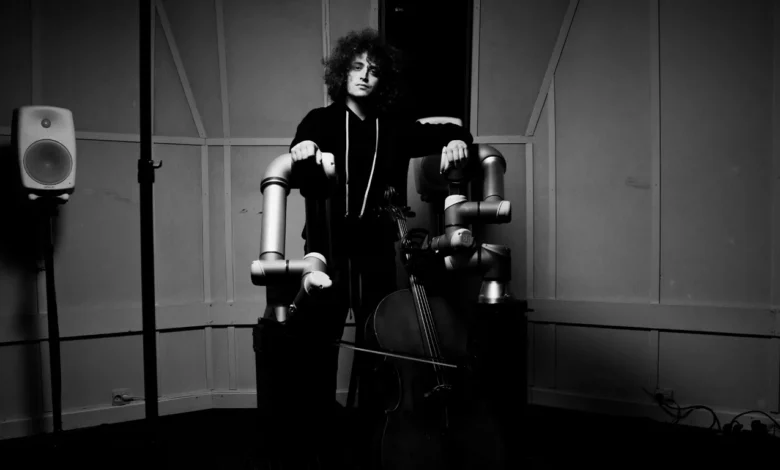
‘Humans, they can’t be replaced’: Jacob Mühlrad on his robot cello player
Swedish composer Jacob Mühlrad explains what his new robotic cellist can add to the classical music world, and what it can’t.
As the orchestra assembled for the final piece of the evening at Malmö Live Concert Hall, there was an unusual member in the pit.
No human performed the cello solo for Swedish composer Jacob Mühlrad’s latest piece. Instead, it was a robot.
Around the propped up cello, two mechanical arms protruded from the ground. One held the bow, attached to robotic appendage directly instead of lightly held between a person’s grasp, with the other using a cylindrical hub of pads to press the neck.
Veer (bot), as the robot is known, has been programmed to play the piece, ‘Veer’, perfectly. As the rest of the orchestra swells, Veer (bot) effortlessly exerts long drawn out notes standing apart – emotionally and physically – from the human musicians.
This isn’t a brute machine imprecisely whacking a bow against four strings. Everything has been thought through. “Even the vibrato can be programmed,” Mühlrad tells Euronews Culture.
Mühlrad is the composer behind Veer (bot)’s professional debut. The 33-year-old wunderkind reached out to fellow Swedish composer and researcher Frederick Gran about his robot creation, the Cello Concerto No. 1.
“We started a conversation and every week we spoke, he developed something new,” Mühlrad recalls.
As Gran added features from synchronisation to tonal capabilities, Mühlrad wondered if the robot had ever played with an orchestra. It hadn’t, and so his next goal was composing a work for the robot to perform live with a full orchestra was born.
As the final piece in a portrait concert of Mühlrad’s work by the Malmö Symphony Orchestra, ‘Veer’ was composed purposely for the addition of the new mechanical cellist. Although Mühlrad notes the potential for a future version of the robot to respond to a conductor like a regular player, this time, the Veer (bot) was entirely pre-recorded down to the tiniest details.
Unconstrained by the limitations of human biology, Veer (bot) can feasibly perform impossibly complex pieces.
“I think it’s very similar to a MIDI Keyboard,” Mühlrad says, explaining how musicians now programme digital keyboards to play pieces beyond the ability of human fingering. “Perhaps it’s more complex as there are more musical parameters at the cello,” he notes qualities like intonation and bow pressure which alter the sound of the string instrument.




